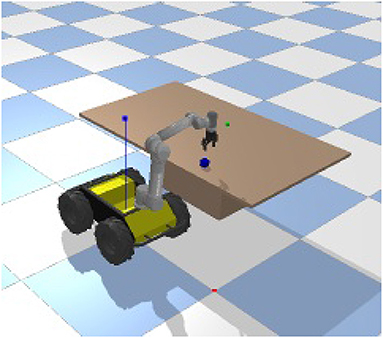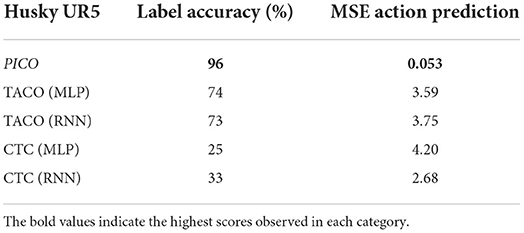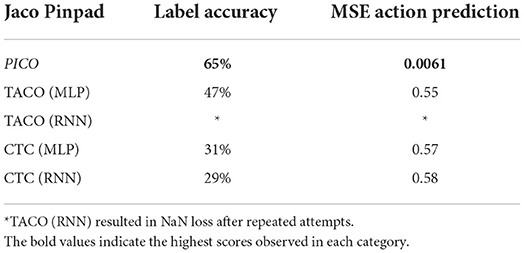- Johns Hopkins Applied Physics Laboratory, Intelligent Systems Center, Laurel, MD, United States
Generalizing prior experiences to complete new tasks is a challenging and unsolved problem in robotics. In this work, we explore a novel framework for control of complex systems called Primitive Imitation for Control (PICO). The approach combines ideas from imitation learning, task decomposition, and novel task sequencing to generalize from demonstrations to new behaviors. Demonstrations are automatically decomposed into existing or missing sub-behaviors which allows the framework to identify novel behaviors while not duplicating existing behaviors. Generalization to new tasks is achieved through dynamic blending of behavior primitives. We evaluated the approach using demonstrations from two different robotic platforms. The experimental results show that PICO is able to detect the presence of a novel behavior primitive and build the missing control policy.
1. Introduction
Neural networks have demonstrated extraordinary ability to control systems with high degrees of freedom. An important challenge is how to control such high-degree of freedom systems with only a few control inputs. One approach to address the scaling challenge is through modularity and hierarchical control mechanisms (Akinola et al., 2017; Shazeer et al., 2017; Zhao et al., 2017). These approaches use the limited number of inputs to select a primitive control policy, from a library of primitive behaviors, and potentially a target. Complex tasks are performed by chaining primitive behaviors.
As an example of this scenario, consider a Universal Robots UR5 (UR, 2019) manipulator mounted on a Clearpath Husky platform (Hus, 2019) as shown in Figure 1. The UR5 is used to demonstrate reaching, grabbing, and lifting a block on a table. Other tasks may require performing these actions in another order, so it may be useful to learn and maintain a collection of these primitive behaviors for later use. While the underlying behavior primitives are well-defined for the reach-and-grasp scenario, other example scenarios may not have as well-defined or labeled primitives. In this work, we assume that the underlying label of the behaviors shown in the task demonstrations is unknown.
The questions we investigate are how might we learn and maintain the primitive library from unlabeled demonstrations and, assuming the behavior primitive library exists, how would one know when to use, adapt, or create a new primitive behavior. We propose that the behavior library should be actively maintained to minimize redundancy and maximize the ability to reconstruct complex tasks through chains of the primitive behaviors. In this work, we explore techniques to directly optimize for these criteria by building on methods that learn from demonstration.
We explore maintaining a behavior primitive library in an online learning scenario. Given a potentially non-empty behavior primitive library and a new set of unlabeled task demonstrations, we seek to update the behavior primitive library to maximally accommodate the new demonstrations while maintaining the ability to reconstruct previously demonstrated trajectories.
Our contribution is an approach called PICO that simultaneously learns subtask decomposition from unlabeled task demonstrations, trains behavior primitives, and learns a hierarchical control mechanism that allows blending of primitive behaviors to create even greater behavioral diversity, an overview is shown in Figure 2. Our approach directly optimizes the contents of the primitive library to maximize the ability to reconstruct unlabeled task demonstrations from sequences of primitive behaviors.
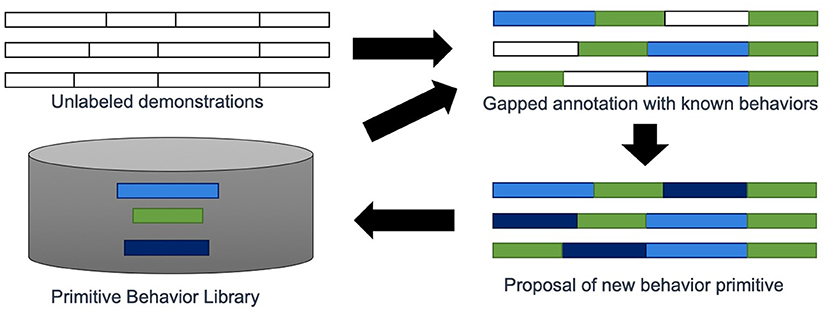
Figure 2. An overview of PICO. The approach takes as input unlabeled demonstrations and a library of primitive behaviors. The goal is to predict the primitive behavior label associated with each time point in all demonstrations. Additional behavior primitive models can be trained to fill gaps that are not well-represented by existing behavior primitives.
2. Preliminaries
Learning from demonstration (LfD) and imitation learning allow agents to execute a task by observing the task being performed (Hussein et al., 2017). In the robotics domain, a goal of imitation learning is to produce a mapping, π, from states to actions, known as a control policy (Argall et al., 2009; Schaal and Atkeson, 2010), that has the maximum likelihood of producing the demonstration dataset , where each ρ = (s1, a1), (s2, a2), …, (sT, aT) is a demonstration trajectory of state, action pairs. The demonstrations can be created by another control policy (Rusu et al., 2015), by a human expert (Konidaris et al., 2012), or in a simulated environment (Shiarlis et al., 2018; Kipf et al., 2019). Let πθ parameterized by θ. The goal is then to optimize Equation (1) by varying θ.
Following optimization, covariate drift can cause errors in the control process that can place the robot in a previously unobserved state. Control policies will have higher action prediction errors in parts of the state space that it has not observed, leading to poor action predictions and compounding errors with increased iterations of the policy. One approach that has been introduced to decrease the impact of covariate shift is to introduce noise into the demonstrations used for learning (Laskey et al., 2017). This approach increases the amount of state space covered by the policy and improves action predictions around the demonstrations, leading to better generalization and error tolerance.
2.1. Model agnostic meta-learning
In meta-learning a model is trained on a variety of learning tasks and the parameters of the method are fine-tuned for generalization. The idea of meta-learning is to combine a set of learner models to improve performance on a task more quickly than one without pretrained models. This is a common strategy for one-shot (Santoro et al., 2016) or few shot scenarios, where a model must be trained using one or a few examples. Some approaches for meta-learning come from the reinforcement learning (Finn et al., 2017), which typically differ in how they update individual learners. Some meta-learning methods update models using gradient information (Finn et al., 2017) and others learn how to update learners from data (Bengio et al., 2002; Andrychowicz et al., 2016).
3. Related work
Imitation learning alone does not provide a mechanism to generalize demonstrations to new tasks. One mechanism to address this challenge is task decomposition, which has the goal of identifying subtasks from demonstration. Subtasks can be made into sub-policies through imitation learning, including methods that combine subtask discovery with imitation learning (Shiarlis et al., 2018; Xu et al., 2018). By decomposing demonstrations into subtasks, it becomes possible to permute the sequence of sub-policies to achieve greater task diversity and generalizability. However, decomposing demonstrations into subtasks that are maximally useful for recombination is a challenge in task decomposition (Shiarlis et al., 2018).
Once sub-task policies are established, a hierarchical control policy can be learned that identifies the sequence of policies needed to achieve a specified goal. Given a sufficiently diverse set of demonstrations the reasoning layer can be learned from a set of demonstrations (Xu et al., 2018). Several approaches for learning hierarchical architectures for control policies from limited demonstrations have been proposed (Duan et al., 2017; Shiarlis et al., 2018; Xu et al., 2018). We were inspired by the work on mixtures-of-experts (Jacobs et al., 1991; Shazeer et al., 2017) which includes a similar hierarchical representation.
Some approaches assume that the behavior primitive library is fully trained in advance (Xu et al., 2018). In the reinforcement learning domain, the options framework (Stolle and Precup, 2002; Kulkarni et al., 2016; Andreas et al., 2017), and hierarchical reinforcement learning (Dietterich, 2000) are common approaches for organizing hierarchies of policies. The techniques in reinforcement learning are often predicated on being able to interact with an environment and collect a lot of data. In this work, we focus on learning hierarchical task decomposition strategies from a limited set of demonstrations.
3.1. Task sketch for sub-policy discovery
Some related approaches (Andreas et al., 2017; Mu et al., 2019) perform demonstration decomposition by combining both demonstrations and task sketches. The literature refers to these approaches as weakly-supervised because the order of tasks is given and the exact transition points within a demonstration must be inferred.
Let be our dataset containing trajectories ρ = [(s0, a0), (s1, a1), …, (sT, aT)] of length T containing state-action tuples (s, a) for state s and action a. Given a library of sub-tasks policies , A task sketch τ = (τ1, τ2, …, τL) is a sequence of sub-tasks labels where L is the length of the sketch. A path is a sequence of sub-task labels ζ = (ζ1, ζ2, …, ζT) where T is the length of a demonstration. We assume that L < < T. We say that a path ζ matches a task sketch τ if τ = ζ after removing all adjacent duplicate sub-tasks in ζ. For example, the path (π2, π2, π2, π3, π3, π1, π1, π1, π1) matches the task sketch (π2, π3, π1).
4. Methods
In this section, we describe the approaches most closely aligned with our work referred to as CTC (Graves et al., 2006) and TACO (Shiarlis et al., 2018). Then, we introduce our approach called Primitive Imitation for Control (PICO).
4.1. Connectionist temporal classification
Given a dataset and task sketch τ, one approach to obtain a set of generalizable sub-tasks is to separately learn alignment of trajectories to the task sketch then learn the control policies for sub-tasks with behavior cloning. Connectionist Temporal Classification (CTC) (Graves et al., 2006) addresses the problem of aligning sequences of dissimilar lengths. There are potentially multiple ways in which a path could be aligned to a task sketch. Let ℤ(T, τ) be the set of all paths of length T that match the task sketch τ. The CTC objective maximizes the probability of the task sketch τ given the input trajectory ρ:
pθ(ζt, |ρ) is commonly represented as a neural network with parameters θ that outputs the probability of each sub-task policy in . The objective is solved efficiently using dynamic programming. Inference using the neural network model is used to find a maximum likelihood path ζ for a trajectory ρ. The labels in ζ provide an association between state-action tuples (st, at) and subtask policies . The state-action policies associated with a single sub-task are used to create a sub-task policy using behavior cloning.
4.2. Temporal alignment for control
Given a demonstration ρ and a task sketch τ, Temporal Alignment for Control (TACO) (Shiarlis et al., 2018) will learn where each subtask begins and ends in the trajectory and simultaneously trains a library of sub-tasks policies . TACO maximizes the joint log likelihood of the task sequence τ and the actions from sub-task policies contained in conditioned on the states. Let aρ and sρ be the set of actions and states, respectively in trajectory ρ.
where p(ζ|sρ) is the product of action probabilities associated with any given path ζ. The path ζ determines which data within ρ corresponds to each sub-task policy π and is the behavior cloning objective from Equation (1).
4.3. Primitive imitation for control (PICO)
In this work, we introduce Primitive Imitation for Control (PICO). The approach differs from previous work in a few important ways. PICO similarly decomposes behavior primitives from demonstration. It optimizes the action conditioned on state and does not require a task sketch, and unlike CTC (Graves et al., 2006), our approach simultaneously learns to segment demonstrations and trains underlying behavior primitive models.
We aim to reconstruct the given trajectories as well as possible using the existing sub-task policy library. As shown in Equation (5), we seek to minimize the sum of squared error between the observed action and the predicted action for all actions over all timepoints T and all trajectories . We refer to this objective as minimizing reconstruction error. Let (sρt, aρt) be the state-action tuple corresponding to ρt timepoint t in trajectory ρ. The action prediction, Equation (6), is the product of the probability p(π|sρt) of a sub-task policy π conditioned on the state sρt and the action predicted by policy π(sρt) for the state sρt. Substituting Equation (6) into Equation (5) results in Equation (7) which is the optimization problem for PICO.
4.4. Neural network architecture
Estimates of both p(π|sρt) and π(sρt) are given by a recurrent neural network architecture. Figure 4 gives an overview of the recurrent and hierarchical network architecture. We solve for the objective in Equation (7) directly by back propagation through a recurrent neural network with Equation (5) as the loss function. The model architecture is composed of two branches that are recombined to compute the action prediction at each timepoint.
To more easily compare with other approaches that do not blend sub-task policies, we estimate the maximum likelihood sub-task policy label at each timepoint. We refer to sub-task policies as behavior primitives. The behavior primitive label prediction is given by the maximum likelihood estimate of π shown in Equation (8) for time t in trajectory ρ.
Figure 3 illustrates how we compute the predicted action ât at time t. In the figure, the probability of π given state sρt is λπ = p(π|sρt) for . The latent representation ht at the current timepoint t is a function of both the value of the latent representation of the previous state ht−1 and the current state st.
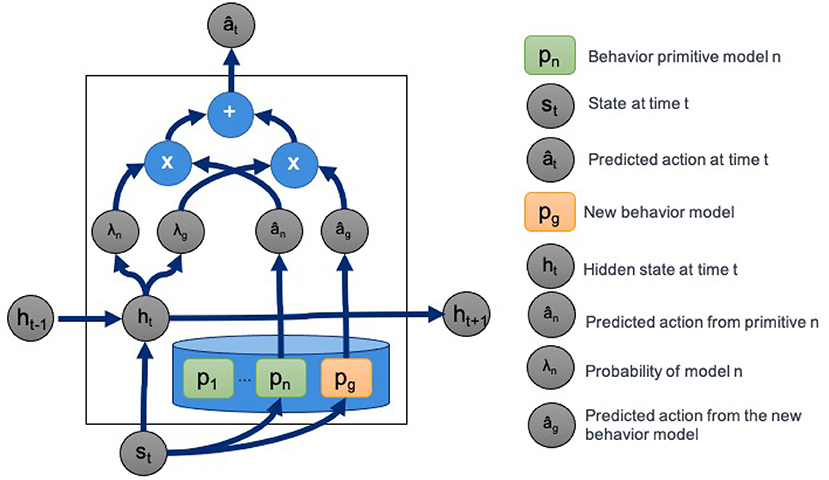
Figure 3. Hierarchical recurrent deep network architecture for task decomposition, novel behavior primitive discovery, and behavior blending.
Figure 4 details the architecture used for PICO based on the Husky+UR5 dataset example. Unless otherwise specified, the fully connected (FC) layers have ReLU activations, except for the output layers from behavior primitive models. The last layer of behavior primitive models have linear activations to support diverse action predictions. While not shown in Figure 4, the network architecture also returns the predicted latent embedding and behavior primitive distribution for additional visualization and analysis.
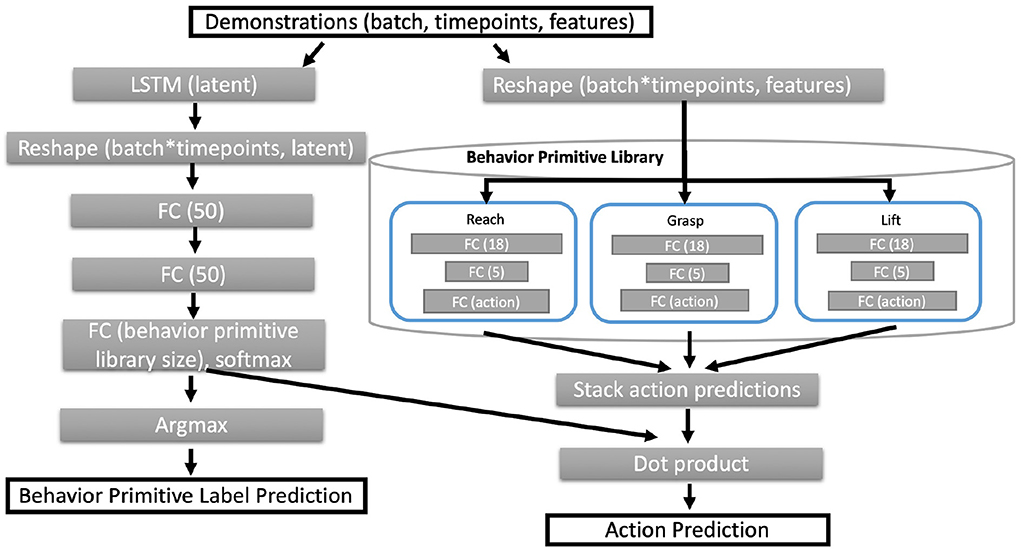
Figure 4. Neural network architecture for PICO. Given a set of input trajectories and a behavior primitive library, the core architecture follows two branches, the left most branch estimates a distribution over the behavior primitives. The right hand branch estimates the action prediction from each primitive behavior sub-model. We compute the predicted action as a linear combination between the behavior primitive distribution and the set of predicted actions from all behavior primitives.
4.5. Discovering and training new behavior primitives
An important aspect of our approach is the ability to discover and create new behavior primitives from a set of trajectories and a partial behavior primitive library. PICO detects and trains new behavior primitive models simultaneously. As shown in Figure 3, PICO supports building new behavior primitive models by adding additional randomly initialized behavior models to the library prior to training. For our experiments, we assume that we know the correct number of missing primitives.
We define a gap in a trajectory as region within a demonstration where actions are not predicted with high probability using the existing behavior primitive models. A gap in a trajectory implies that the current library of behavior primitives is insufficient to describe a set of state-action tuples ρ in some part of the given trajectory. This also implies that the probability p(π|ρt) that the data ρt for time point t was generated by the current library of behavior primitive models is low for all . These low probabilities increase the likelihood that an additional randomly initialized behavior primitive policy πnew might have a higher probability p(πnew|ρt)>p(π|ρt) for . The data ρt is then used to train πnew. For nearby data in the same gap region ρt+1, it is now more likely that p(πnew|ρt+1)>p(π|ρt+1) for . This mechanism allows πnew to develop in to a new behavior primitive that is not well-covered by existing primitives.
4.6. Training details
PICO is trained end-to-end by back propagation. This is possible because all functions in the model are differentiable with the exception the argmax function. For experiments making use of pretrained behavior primitive models, the contents of the behavior primitive library are trained using the DART (Laskey et al., 2017) technique for imitation learning.
As shown in Equation (5), the loss used to train the model is mean squared error between the predicted and observed actions over all timepoints and all demonstrations. There is no loss term for label prediction accuracy, because we assume that the demonstrations are unlabeled.
4.7. Metrics
Two metrics are computed to estimate performance. First, we evaluate mean squared error (MSE) as shown in Equation (5) between the predicted and given action. Second, we compute behavior primitive label accuracy which is a comparison between the predicted and given behavior primitive label. Label accuracy is computed as the number of matching labels divided by the total number of comparisons. Both metrics are computed over all timepoints and over all demonstrations in the test set.
4.8. Baseline implementations
Shiarlis et al. (2018) developed TACO, which aligned subtasks to demonstrations given a library of primitives and a task sketch, where a task sketch describes the sequence in which subtasks will appear. In addition, in their recent work (Shiarlis et al., 2018), they extended the connectionist temporal classification (CTC) algorithm (Graves et al., 2006), commonly used to align sequences for speech recognition, for use with identifying subtasks. For this work, we use TACO and the extended version of CTC as baseline comparisons for our algorithm, using an open source implementation1. Both were tested using MLP and RNN architectures.
5. Experiments and discussion
We evaluate PICO using a reach-grab-lift task using a Husky+UR5 environment. The dataset consists of 100 demonstrations of a Clearpath Husky robot with a UR5 manipulator performing a variety of reach, grasp, and lift tasks (see Figure 1). The number of time steps in the demonstrations varied from 1,000 to 1,800, but each used all three primitives: reach, grasp, and lift.
The first experiment quantifies the ability of PICO to identify primitive task labels from demonstration independently from learning behavior primitives. The second experiment evaluates the ability of PICO to identify parts of demonstrations that are not represented by existing behavior primitives and rebuild the missing behavior primitive.
5.1. Reconstruction from existing primitives
Our initial experiment is an ablation study that separately evaluates the estimate of the primitive behavior probability distribution and the action predictions from learning behavior primitives. We train and freeze behavior primitive models for reach, grasp, and lift using the ground truth labeled data from trajectories. We evaluated PICO, TACO (Shiarlis et al., 2018), and CTC based on label classification accuracy. For Taco and CTC we additionally compared the methods using MLP and RNN based underlying network models. We evaluated all methods based on an 80/20 split of demonstrations into training and test sets. The average of five independent runs were obtained for each approach. In Table 1, we show the results of the comparison.
Figure 5A shows a comparisons between the predicted label based on Equation (8) and the ground truth label. Over all trajectories in the test set, the average label classification accuracy was 96% compared to the ground truth label. The summary of results are shown in Table 1.
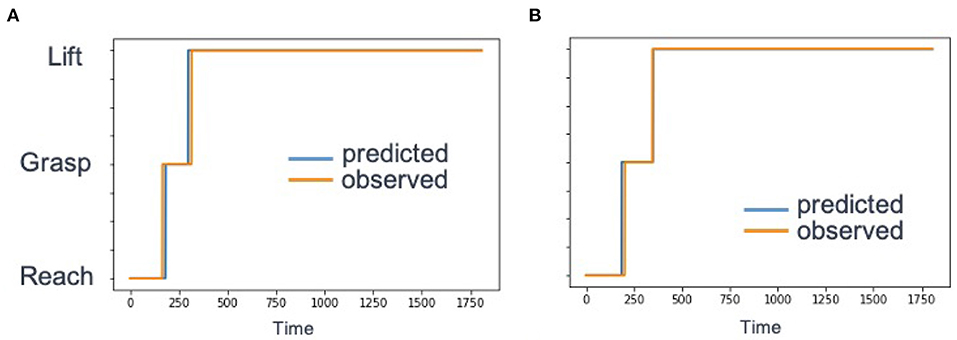
Figure 5. Example behavior primitive label accuracy for a single test demonstration. We compared the label predictions given by PICO (red) to the ground truth (blue). (A) A sample reconstruction for a single trajectory with an existing behavior primitive library. Timepoints are on the x-axis. and behavior primitive label is on they y-axis. The labels 0, 1, and 2 correspond to reach, grasp, and lift, respectively. (B) Reconstruction of an example trajectory and discovery of a missing behavior primitive (grasp).
5.2. Behavior primitive discovery
In our next experiment, we evaluate the ability of PICO to recognize and build a missing behavior primitive model. We ran a leave-one-behavior-out experiment where one of the three primitives (i.e., reach, grasp, lift) was replaced with a randomly-initialized behavior primitive. This experiment used the same 100 trajectories on the Husky+UR5 dataset discussed in the previous section and a 80/20 split between training and validation sets. Again, five trials were run with the training and validation sets randomly chosen. The label accuracy and action prediction MSE are shown in Figure 6. The leftmost bar shows the results with all primitives pre-trained with behavior cloning. The remaining bars show the accuracy when reach, grasp, and lift, respectively, were replaced with the gap primitive. Note, the gap primitive was updated throughout the training with back-propagation such that the final primitive ideally would perform as well as the original pre-trained, behavior-cloned version; this comparison is shown with the action prediction MSE. The error bars show the standard deviation across the five trials. While the label accuracy across all three replaced primitives is approximately the same, the action prediction for the lift primitive is significantly worse. We believe this is due to the larger variance in lift trajectories. Unlike the reach and grasp which have restrictions placed on their final target position (it needs to be near the block), the final position of lift is randomly placed above the block's starting position.
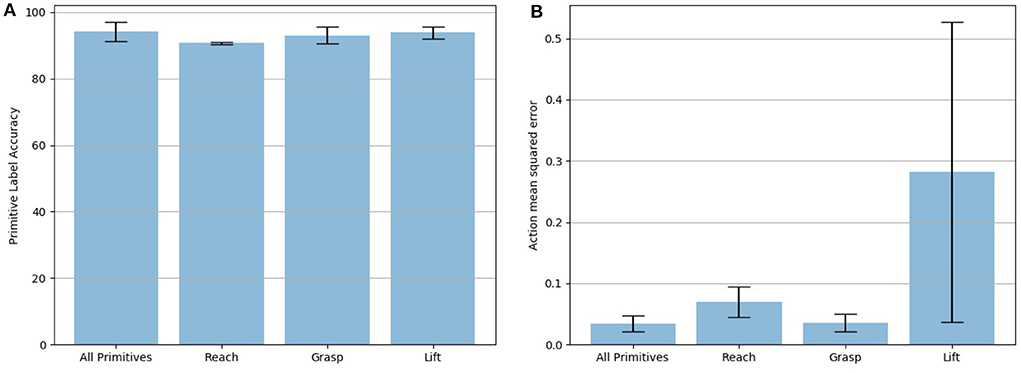
Figure 6. Accuracy of PICO to correctly identify a primitive's label on the validation set (20 randomly selected trajectories). (A) The leftmost bar shows performance when all primitives are in the library, successive bars denote accuracy when the reach, grasp, and lift primitives are dropped out and learned from a randomly generated “gap” primitive. Error bars represent the standard deviation across five validation trials. (B) Mean squared error between the ground truth action and the learned model's estimate averaged across 20 randomly selected test trajectories five times.
As shown in the sample trajectory in Figure 5B, the label prediction of the trained model closely aligns with the ground truth label from the example trajectory. Over all of the test trajectories, the average label classification accuracy was 96%.
5.3. Visualizing the learned latent space
To better understand the role of the embedding space for predicting the primitive probability distribution, we visualized the embedding of all states vectors from the test set in the recurrent hidden layer. We would expect that a useful latent embedding would naturally cluster states that correspond to different primitives into distinct locations in the embedding space. Figure 7 shows layout of the latent space in two dimensions. Each point corresponds to a state vector from the test dataset. The points are colored by the ground truth label.
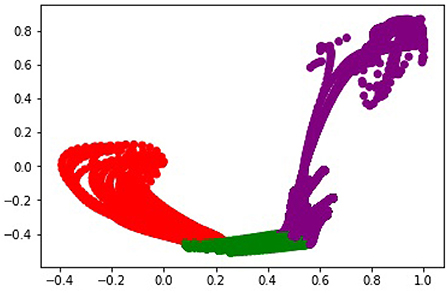
Figure 7. The organization of the learned latent space associated with the Husky-UR5 dataset for reach, grasp, and lift (red, green, and purple, respectively).
5.4. Jaco dial domain dataset
We also make use of the Jaco dial domain dataset (Shiarlis et al., 2018) illustrated in Figure 8. The dial dataset is composed of demonstrations from a Jaco manipulator pressing four keys in sequence (e.g., 3, 5, 4, 5). The positions of the keys are randomly shuffled for each demonstration, but the position of each key is given in the state vector. Repetitive use of primitives are allowed in the demonstrations. The intention with this dataset is to treat pressing an individual digit as a behavior primitive. For this dataset, label prediction accuracy is a challenging metric without a task sketch because the starting position of the Jaco may not provide clues about which button will be pressed. As the Jaco gets closer to a button, it becomes more clear which button will be pressed. The dataset of dialpad demonstrations were generated using default parameters and code from TACO (Shiarlis et al., 2018).
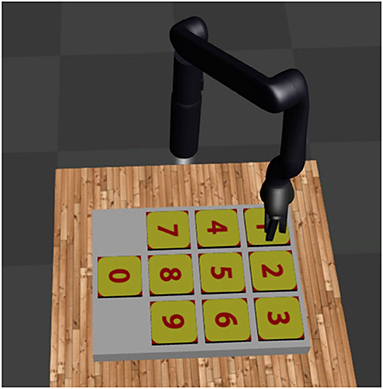
Figure 8. The joint-domain dial scenario. A Jaco manipulator modeled in Mujoco presses a sequences of four keys on a dialpad. The positions of the keys are randomly shuffled for each demonstration. The positions of the joints and positions of the keys are given as state information.
5.5. Dial domain comparison
The goal of this comparison is to evaluate the label prediction accuracy of the metacontroller in PICO. To isolate the label predictions of the metacontroller, the behavior primitive library is pretrained on the training dataset including 1,200 demonstrations and frozen. Label classification and action prediction accuracy is then evaluated on the test set including 280 demonstrations.
The average results of five runs are shown for TACO and CTC. We evaluate each approach using the same label accuracy and action prediction metrics. The summary of results are shown in Table 2. We found that our approach achieves the highest label accuracy at 65%. The overall label accuracy of PICO on the dial dataset is lower than the Husky+UR5 dataset. Additional analysis revealed that many of the mislabeling occurred at the beginning of a new key press where context about where the Jaco is moving next is weakest. The dataset is also more challenging than the Husky dataset because the number of unique behavior primitives has increased from 3 to 10.
Also of note, we compare our results to TACO which is a weakly supervised approach. TACO is given the ordering of tasks. For task sequences of length 4, this means that a random baseline would be expected to achieve an accuracy of 25%. For an unlabeled approach like PICO, any of the 10 behavior primitives could be selected at each timepoint. With only unlabeled trajectories, the expected accuracy of a random baseline would be 10%.
In both the reach and grasp and pinpad domain, we observed large performance gains in our approach over both TACO and CTC. Both and TACO align actions to behaviors and train new behaviors in a single end-to-end model. In contrast, CTC optimizes the alignment of actions to behavior labels separately from training new primitive behaviors. Shiarlis et al. (2018) point out that the joint optimization results in superior performance of TACO over CTC. We can partially attribute the superior performance of our approach over CTC to the use of an end-to-end model and joint optimization.
We also observed superior performance of our approach over TACO (Shiarlis et al., 2018). The key difference between our approach and TACO is that our approach uses soft attention over behavior primitives to learn a behavior blending strategy. In contrast, TACO makes use of hard attention over behaviors for action prediction. Consequently, our approach effectively makes use of more parameters for each action prediction increasing the expressive power of our approach relative to TACO with a similar network size.
Several interesting open challenges remain. The introduction of methods that can accommodate any number of behaviors without reshaping the core network would be a valuable next step. Also, new representations are needed that can accommodate behaviors primitives with high variance.
6. Conclusion
In this paper, we describe PICO, an approach to learn behavior primitives from unlabeled demonstrations and a partial set of behavior primitives. We optimize a metric that directly minimizes reconstruction error for a set of demonstrations using sequences of behavior primitives. We directly compare our results to similar approaches using demonstrations generated from simulations of two different robotic platforms and achieve both better label accuracy and reconstruction accuracy as measured by action prediction mean squared error.
Data availability statement
The original contributions presented in the study are included in the article/supplementary materials, further inquiries can be directed to the corresponding author/s.
Author contributions
CR, KP, and CA carried out the experiments. All authors reviewed the manuscript.
Conflict of interest
The authors declare that the research was conducted in the absence of any commercial or financial relationships that could be construed as a potential conflict of interest.
Publisher's note
All claims expressed in this article are solely those of the authors and do not necessarily represent those of their affiliated organizations, or those of the publisher, the editors and the reviewers. Any product that may be evaluated in this article, or claim that may be made by its manufacturer, is not guaranteed or endorsed by the publisher.
Footnotes
References
Akinola, I., Chen, B., Koss, J., Patankar, A., Varley, J., and Allen, P. (2017). “Task level hierarchical system for BCI-enabled shared autonomy,” in 2017 IEEE-RAS 17th International Conference on Humanoid Robotics (Humanoids) (Birmingham), 219–225. doi: 10.1109/HUMANOIDS.2017.8246878
Andreas, J., Klein, D., and Levine, S. (2017). “Modular multitask reinforcement learning with policy sketches,” in Proceedings of the 34th International Conference on Machine Learning, Vol. 70 (Sydney, NSW), 166–175.
Andrychowicz, M., Denil, M., Gomez, S., Hoffman, M. W., Pfau, D., Schaul, T., et al. (2016). Learning to learn by gradient descent by gradient descent. arXiv [Preprint]. arXiv: 1606.04474. Available online at: https://arxiv.org/pdf/1606.04474.pdf
Argall, B., Chernova, S., Veloso, M., and Browning, B. (2009). A survey of robot learning from demonstration. Robot. Auton. Syst. 57, 469–483. doi: 10.1016/j.robot.2008.10.024
Bengio, Y., Bengio, S., and Cloutier, J. (2002). “Learning a synaptic learning rule,” in IJCNN-91-Seattle International Joint Conference on Neural Networks (Seattle, WA).
Dietterich, T. G. (2000). Hierarchical reinforcement learning with the maxq value function decomposition. J. Artif. Intell. Res. 13, 227–303. doi: 10.1613/jair.639
Duan, Y., Andrychowicz, M., Stadie, B., Ho, J., Schneider, J., Sutskever, I., et al. (2017). “One-shot imitation learning,” in Advances in Neural Information Processing Systems (Long Beach, CA), 1087–1098.
Finn, C., Abbeel, P., and Levine, S. (2017). “Model-agnostic meta-learning for fast adaptation of deep networks,” in Proceedings of the 34th International Conference on Machine Learning, Vol. 70 (Sydney, NSW), 1126–1135.
Graves, A., Fernández, S., Gomez, F., and Schmidhuber, J. (2006). “Connectionist temporal classification: labelling unsegmented sequence data with recurrent neural networks,” in Proceedings of the 23rd International Conference on Machine Learning (Pittsburgh, PA), 369–376. doi: 10.1145/1143844.1143891
Husky (2019). Available online at: www.clearpathrobotics.com/husky-unmanned-ground-vehicle-robot/ (accessed September 10, 2019).
Hussein, A., Gaber, M., Elyan, E., and Jayne, C. (2017). Imitation learning: a survey of learning methods. ACM Comput. Surv. 50, 21:1–21:35. doi: 10.1145/3054912
Jacobs, R. A., Jordan, M. I., Nowlan, S. J., and Hinton, G. E. (1991). Adaptive mixtures of local experts. Neural Comput. 3, 79–87. doi: 10.1162/neco.1991.3.1.79
Kipf, T., Li, Y., Dai, H., Zambaldi, V., Sanchez-Gonzalez, A., Grefenstette, E., et al. (2019). “CompILE: compositional imitation learning and execution,” in Proceedings of the 36th International Conference on Machine Learning, Vol. 97 of Proceedings of Machine Learning Research (Long Beach, CA), 3418–3428.
Konidaris, G., Kuindersma, S., Grupen, R., and Barto, A. (2012). Robot learning from demonstration by constructing skill trees. Int. J. Robot. Res. 31, 360–375. doi: 10.1177/0278364911428653
Kulkarni, T., Narasimhan, K., Saeedi, A., and Tenenbaum, J. (2016). “Hierarchical deep reinforcement learning: Integrating temporal abstraction and intrinsic motivation,” in Advances in Neural Information Processing Systems (Barcelona), 3675–3683.
Laskey, M., Lee, J., Fox, R., Dragan, A., and Goldberg, K. (2017). “Dart: Noise injection for robust imitation learning,” in Conference on Robot Learning (Mountain View, CA: PMLR), 143–156.
Mu, T., Goel, K., and Brunskill, E. (2019). “Plots: procedure learning from observations using subtask structure,” in Proceedings of the 18th International Conference on Autonomous Agents and MultiAgent Systems (Montreal: International Foundation for Autonomous Agents and Multiagent Systems), 1007–1015.
Rusu, A. A., Colmenarejo, S. G., Gulcehre, C., Desjardins, G., Kirkpatrick, J., Pascanu, R, et al. (2015. Policy distillation. arXiv [Preprint]. arXiv: 1511.06295. Available online at: https://arxiv.org/pdf/1511.06295.pdf.
Santoro, A., Bartunov, S., Botvinick, M., Wierstra, D., and Lillicrap, T. (2016). One-shot learning with memory-augmented neural networks. arXiv:1605.06065. doi: 10.48550/arXiv.1605.06065
Schaal, S., and Atkeson, C. (2010). Learning control in robotics. IEEE Robot. Autom. Mag. 17, 20–29. doi: 10.1109/MRA.2010.936957
Shazeer, N., Mirhoseini, A., Maziarz, K., Davis, A., Le, Q., Hinton, G., et al. (2017). Outrageously large neural networks: The sparsely-gated mixture-of-experts layer. arXiv [Preprint]. arXiv: 1701.06538. Available online at: https://arxiv.org/pdf/1701.06538.pdf
Shiarlis, K., Wulfmeier, M., Salter, S., Whiteson, S., and Posner, I. (2018). “Taco: learning task decomposition via temporal alignment for control,” in International Conference on Machine Learning (Stockholm).
Stolle, M., and Precup, D. (2002). “Learning options in reinforcement learning,” in Abstraction, Reformulation, and Approximation, eds S. Koenig andR. C. Holte (Berlin; Heidelberg: Springer), 212–223. doi: 10.1007/3-540-45622-8_16
Universal Robots (2019). Available online at: www.universal-robots.com (accessed September 10, 2019).
Xu, D., Nair, S., Zhu, Y., Gao, J., Garg, A., Fei-Fei, L., et al. (2018). “Neural task programming: learning to generalize across hierarchical tasks,” in IEEE International Conference on Robotics and Automation (Brisbane), 1–8 doi: 10.1109/ICRA.2018.8460689
Keywords: neural networks, robotics, artificial intelligence, temporal network, learning from demonstration
Citation: Rivera C, Popek KM, Ashcraft C, Staley EW, Katyal KD and Paulhamus BL (2022) Learning generalizable behaviors from demonstration. Front. Neurorobot. 16:932652. doi: 10.3389/fnbot.2022.932652
Received: 30 April 2022; Accepted: 12 September 2022;
Published: 03 October 2022.
Edited by:
Alexander N. Gorban, University of Leicester, United KingdomReviewed by:
Stefania Bruni, La Sapienza University, ItalyXinyun Zou, California Institute of Technology, United States
Copyright © 2022 Rivera, Popek, Ashcraft, Staley, Katyal and Paulhamus. This is an open-access article distributed under the terms of the Creative Commons Attribution License (CC BY). The use, distribution or reproduction in other forums is permitted, provided the original author(s) and the copyright owner(s) are credited and that the original publication in this journal is cited, in accordance with accepted academic practice. No use, distribution or reproduction is permitted which does not comply with these terms.
*Correspondence: Corban Rivera, Y29yYmFuLnJpdmVyYUBqaHVhcGwuZWR1
 Corban Rivera
Corban Rivera Katie M. Popek
Katie M. Popek